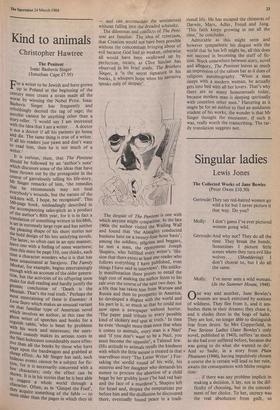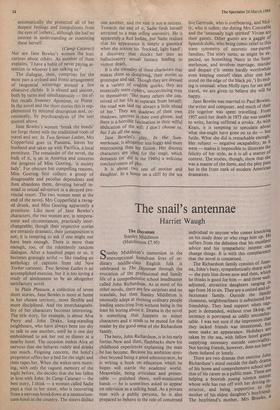Singular ladies
Lewis Jones
The Collected Works of Jane Bowles (Peter Owen £10.50)
Gertrude:They say red-haired women go wild a lot but I never picture it that way. Do you?
Molly: I don't guess I've ever pictured women going wild.
Gertrude:And why not? They do all the time. They break the bonds. Sometimes I picture little scenes where they turn evil like wolves... (Shuddering) I don't choose to, but I do all the same.
Molly: I've never seen a wild woman. (In the Summer House, 1948) One way and another, Jane Bowles's women are much exercised by notions of wildness. They flee from it, and it am- bushes them in their dreams; they chase it, and it eludes them in the bogs of habit. They are lost, no longer able to distinguish fear from desire. So Mrs Copperfield, in Two Serious Ladies (Jane Bowles's only novel, published in 1943), suffers 'as much as she had ever suffered before, because she was going to do what she wanted to do'. And so Sadie, in a story from Plain Pleasures (1946), having impulsively chosen a course she is certain will lead to her ruin, awaits the consequences with blithe resigna- tion:
... if there was any problem implicit in making a decision, it lay, not in the dif- ficulty of choosing, but in the conceal- ment of her choice. To her, secrecy was the real absolution from guilt, so automatically she protected all of her deepest feelings and compulsions from the eyes of [others], although she had no interest in understanding or examining these herself.
(Camp Cataract) Nor are Jane Bowles's women the least curious about others. As another of them explains, 'I have a habit of never paying at- tention to whoever I am talking to.'
The dialogue, then, comprises for the most part a stylised and ironic arrangement of tangential witterings around a few obsessive cliches. It is absurd and sinister, both by turns and simultaneously — the ef- fect recalls Sweeney Agonistes, or Pinter. In the novel and the short stories this is sup- plemented by minimal description and, oc- casionally, by psychoanalysis of the sort quoted above.
Jane Bowles's women 'break the bonds' (or forge them) with the traditional tools of travel and sex. In Two Serious Ladies, Mrs Copperfield goes to Panama, leaves her husband and takes up with Pacifica, a local prostitute. The remainder of the novel, the bulk of it, is set in America and concerns the progress of Miss Goering, 'a society lady'. For obscure but compelling reasons, Miss Goering first collects a group of disagreeable and peculiar dependents and then abandons them, devoting herself in- stead to sexual adventure in a decayed pro- vincial resort. The two women meet at the end of the novel, Mrs Copperfield a ravag- ed drunk, and Miss Goering apparently a prostitute. Like most of Jane Bowles's characters, the two women are, in tempera- ment and circumstances, practically inter- changeable; though their respective stories are certainly dramatic, their juxtaposition is not; it is tempting to ask if one might not have been enough. There is more than enough, too, of the relentlessly random dialogue. After a hundred pages or so, it becomes gratingly artful — like reading an anthology of captions from old New Yorker cartoons. Two Serious Ladies is an accomplished exercise, but it is too loving a study of aimlessness to be an altogether satisfactory novel.
In Plain Pleasure, a collection of seven short stories, Jane Bowles is more at home in her chosen territory, more flexible and more disciplined. And the interchangeabi- lity of her characters becomes interesting. The title story, for example, is about Alva Perry and John Drake, long-standing neighbours, who have always been too shy to talk to one another, until he is one day emboldened to ask her out to dinner at a nearby hotel. The occasion makes Alva so nervous that she behaves rudely and drinks too much. Feigning concern, the hotel's proprietor offers her a bed for the night and then rapes her. When she wakes next morn- ing, with only the vaguest memory of the night before, she decides that she has fallen in love with John. In Camp Cataract — the best story, I think — a woman called Sadie pays a visit to her sister, who is recovering from a nervous breakdown at a sanatorium- cum-hotel in the country. The sisters dislike one another, and the visit is not a success. Towards the end of it, Sadie finds herself attracted to a man selling souvenirs. He is apparently a Red Indian, but Sadie realises that his appearance is simply a gimmick when she notices his 'freckled, light hand'; a discovery that shocks her into an hallucinatory sexual fantasy leading to violent death.
It is the unreality of these characters that makes them so disturbing, their stories so grotesque and sad. Though they are dressed in a variety of credible quirks, they are essentially mere ciphers, unconvincing even to themselves: :like many others she con- ceived of her life as separate from herself; the road was laid out always a little ahead of her.' They are shadows of their own shadows, spectres in their own gloom, and there is a horrible fascination in their wilful abdication of the will: I don't choose to, but I do all the same.
Jane Bowles's play, In the Sum- merhouse, is altogether less foggy and more entertaining than her fiction. Her discrete characters are ideal for the stage, which demands (or did in the 1940s) a welcome conclusiveness of plot.
It is about two
sets of mother and daughter. In a house on a cliff by the sea
live Gertrude, who is overbearing, and Mol- ly, who is sullen; the doting Mrs Constable and the 'unusually high spirited' Vivian are their guests. Other guests are a gaggle of Spanish slobs, who bring comic relief to this stern symmetry of neurotic one-parent families. The story turns, as might be ex- pected, on Something Nasty in the Sum- merhouse, and involves marriage, murder and despair (`It seems hardly worthwhile even keeping oneself clean after one has stood on the edge of the black pit.') Its end- ing is unusual: when Molly opts for sex and travel, we are given to believe she will be happy.
Jane Bowles was married to Paul Bowles, the writer and composer, and much of their life together was spent travelling. From 1957 until her death in 1973 she was unable to write, having suffered a stroke. As with Keats, it is tempting to speculate about what she might have gone on to do — but futile. What she did is remarkable enough. Her subject — negative incapability, as it were — makes it impossible to illustrate the felicity of her style, as it is all a matter of context. The stories, though, show that she was a master of the form, and the play puts her in the front rank of modern American dramatists.











































 Previous page
Previous page